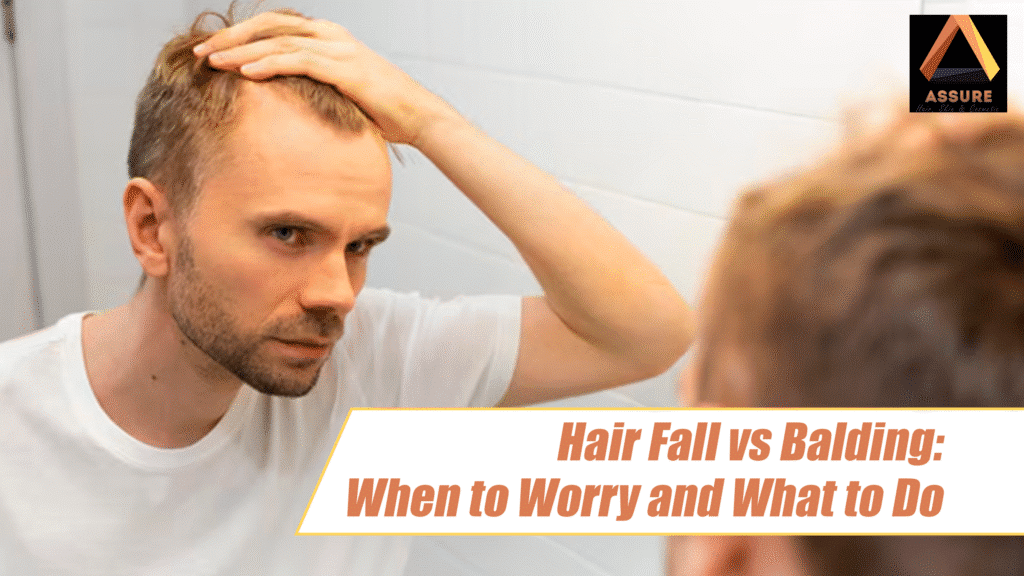Follicle Count:
Follicle Count:

All of us experience hair fall. It’s really common to find some threads in the shower or on your cushion. When does it, however, go too far? When should you begin to worried that it goes beyond mere shedding? This is the area of common misunderstanding about hair loss vs fall.
Many, particularly between the ages of 25 and 55, start to wonder, “Am I balding?” or “Is this just regular hair fall?” The first step toward preserving your peace of mind and hair is awareness of the differences. Let’s discuss Hair fall vs hair loss.
Though it sounds like a little vocabulary change, the terms hair fall vs hair loss really differ greatly. Normal daily loss of 50 to 100 hairs called hair fall. Your hair sheds naturally to allow fresh development space. There is a good cycle there. That is simply hair fall if you comb your hair and notice a few strands.
Hair loss is the condition whereby the shedding exceeds usual and fresh hair stops coming back. Bald areas or thinning patches may follow from this. Usually more serious, it suggests an underlying issue. The tricky part? The shift from hair fall to hair loss can catch you by surprise. There has been major damage done by the time many individuals become aware.
Let us keep things basic here. Natural hair fall is what it is. For a number of reasons.
A poor diet can also be a factor; one may not obtain enough iron or protein. Still, when does it cease being normal? When does the argument on hair fall versus hair loss become personal?
Many individuals wonder, “Am I balding?” but have no idea what warning signals to be on lookout. Here’s what to watch for:
Knowing the differences also helps one to grasp the cause. Let’s delve farther.
Changes in hormones (such as those brought on by pregnancy)
Usually, daily causes of your hair fall stop with some basic lifestyle changes. But if you have hair loss, you usually need to see a doctor.
People lose fifty to hundred hairs every day on average. One would classify this as normal hair fall. The American Academy of Dermatology claims that 25% of women and almost 50% of men show obvious hair loss by the time they are 50. These figures demonstrate that you are not alone and that, contrary to general belief, this is really normal.
Though frightening, this is an important question.
Should you respond “yes” to them, it could be more than simply hair fall. Early baldness recognition increases your chances of slowing or perhaps stopping the process.
Assume you now know your position in the hair fall against the hair loss path. Then what?
Often, the best course of treatment relies on how early you act. If you wait too long, choices could get few.
Hairline design has purposes beyond only aesthetic ones. This is a big determinant of how uncomfortable or natural hair restoration looks.
If you’re thinking about treatments, always choose for facilities that give careful, natural-looking hairline design top priority to minimize obvious scars.
Let’s dispel some really major misconceptions in the air.
Hair fall always means you’re going bald: The natural cycle of hair includes shedding. Look for trends rather than merely haphazard threads.
The comparison between hair fall and hair loss goes beyond the count of hairs discovered on your brush. It’s about knowing what’s typical and what should raise questions. Everyone has hair fall. Conversely, hair loss is something to observe and take action against. Early help seeking, asking oneself, “Am I balding?” and paying attention to the indicators of balding can make a big impact.
Recall that too long waiting could restrict your possibilities. If you’re not sure, always the wise action is to see a specialist. Go to AssureClinic.com for professional direction and actual answers. For expert guidance and real solutions, visit AssureClinic.com.
Welcome to India’s Leading Hair & Skin Clinic
Transforming Lives with Expert Care and Advanced Techniques

Read our latest articles on hair and skin care.
Copyright © Edit Hair and Skin Clinic Pvt Ltd | All Rights Reserved | Privacy Policy | Payment T&C | Shipping Policy | Cancellation Policy |

